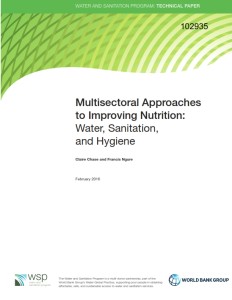Multisectoral Approaches to Improving Nutrition: Water Sanitation and Hygiene
In February 2016, the Water and Sanitation Program released a new technical paper on how water, sanitation and hygiene (WASH) and nutrition sectors can work more closely to achieve better outcomes. According to the paper, Child undernutrition and poor conditions of WASH coexist in many low- and…
 In February 2016, the Water and Sanitation Program released a new technical paper on how water, sanitation and hygiene (WASH) and nutrition sectors can work more closely to achieve better outcomes. According to the paper, Child undernutrition and poor conditions of WASH coexist in many low- and middle-income countries. Sub-Saharan Africa and South Asia together account for the highest burden of child undernutrition and poor WASH globally.
In February 2016, the Water and Sanitation Program released a new technical paper on how water, sanitation and hygiene (WASH) and nutrition sectors can work more closely to achieve better outcomes. According to the paper, Child undernutrition and poor conditions of WASH coexist in many low- and middle-income countries. Sub-Saharan Africa and South Asia together account for the highest burden of child undernutrition and poor WASH globally.
The paper addresses this objective from both the WASH perspective, on how nutrition-specific programs can provide an alternative platform to deliver services at scale and more cost-effectively; and the nutrition perspective, on how WASH interventions can be adapted to include nutritional considerations, making them more nutrition-sensitive, and maximise nutritional impact. It identifies the following three ways to make WASH interventions more nutrition-sensitive:
- Enhance the design of policy and lending operations in the WASH sector to maximize the impact on nutrition outcomes for the poor
- Provide guidance on effective ways to integrate WASH with nutrition-specific and other nutrition-sensitive intervention
- Measure the potential impact of activities on nutrition through meaningful outcome indicators, such as infrastructure quality, usage (behavior), and maintenance
The document outlines the rationale for nutrition-sensitive WASH, summarizes the scientific evidence on the pathways through which WASH impacts nutritional outcomes, discusses the challenges and opportunities for nutrition-sensitive WASH, and proposes a set of practical strategies and enhancements to existing project design that offer promising opportunities to impact nutritional outcomes.
Despite well-known challenges to effective integration, an emerging interest in and attention to the role of WASH, and sanitation in particular, on nutritional outcomes provides a window of opportunity to influence policy and program design for greater impacts on nutrition. This paper explains why WASH is important for nutrition and vice versa, and draws on past experience with multisectoral approaches in the World Bank Group to outline practical steps for making the WASH sector more nutrition-sensitive, and ways that the nutrition sector can effectively integrate WASH interventions.
Download the technical paper > Multisectoral Approaches to Improving Nutrition: Water, Sanitation, and Hygiene (English only)
The Water and Sanitation Program
The Water and Sanitation Program is a multi-donor partnership, part of the World Bank Group’s Water Global Practice, supporting poor people in obtaining affordable, safe, and sustainable access to water and sanitation services. The Program began in 1978 as a cooperative effort between The World Bank and the United Nations Development Program to look at cost-effective technologies and models for providing safe water and sanitation to the world’s poor.
Learn more > Water and Sanitation Program
Learn more > World Bank Group’s Water Global Practice